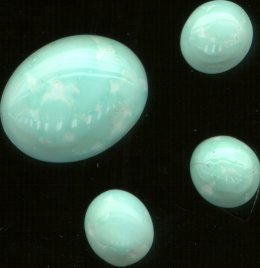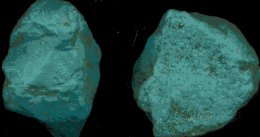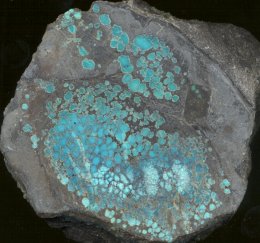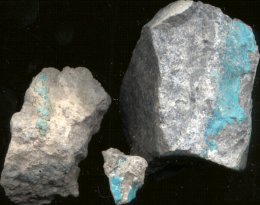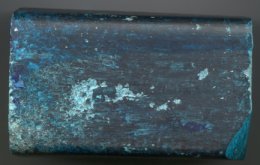If you were born in December, you have the choice of at least two different birth stones. Turquois is on of the choices and zircon is the other. Historically, turquois has been a very important and long used stone. It has been found among Egyptian artifacts including jewelry and decoration on tombs. The term turquois is probably derived from the French pierre turquois (Turkish stone). The name appears both with a final "e" (turquoise) and without the final "e" (turquois). Mineralogists have preferred the latter spelling and it is the custom of the jewelry industry to apply the names and spellings as do the mineralogists since mineral names are generally universal throughout the scientific world.
In the old world, the Egyptians and Persians and Mongols valued turquois highly. Turquois is a very popular stone in Tibet. The Persians were extremely fond of fine, sky blue turquois and the name "Persian Turquois" is now applied to these stones as a color grade rather than as an indication of source area. In the New World, the Aztecs and Incas utilized turquois but the American Indians of the Southwest have probably brought more attention to this stone in recent years than any other culture. Visits to jewelry stores, art and craft shows and gem and mineral shows will usually provide many examples of squash blossom necklaces and thunderbird motifs.
Turquois is a hydrous phosphate of aluminum and copper CuO.3Al2O3.2P2O5.9H2O. Most turquoise has been found in deeply weathered and altered rhyolitic volcanic rocks. Turquois may be a weathering product of the mineral apatite, or it may even include some organic phosphate. Turquois forms triclinic crystals---three unequal axes, none of which intersect at right angles. Only micro- or very minute crystals if turquois are known. Strangely, the most common occurrence of turquois crystals has been in Virginia, an area from which little, if any, gem turquois has been produced. Turquois is fairly hard, 5-6 on a scale of 10. It may be chalky to brittle, the latter showing a conchoidal fracture. Better rough grades may have a waxy luster whereas lower grades are dull. The chalky material is often impregnated with a resin to make it more durable and more lustrous. The resin-treated turquois can usually be detected by odor. The specific gravity ranges from about 2.60 to 2.83.
Turquois is almost always opaque but rare, translucent stones are known to exist. The refractive indexes range from 1.61 on the low end to 1.62 in the middle and 1.65 on the high side of the scale. It is biaxial positive and has a fairly high dispersion. Optical tests are usually not needed to determine if a stone is turquois as physical tests will almost always suffice.
Turquois may form as chalky coatings or finely disseminated crystals in small cavities and crystal interstices in the host rock. This fact has led to the development of reconstituted turquois. The rock that contains turquois is finely pulverized and the turquois is separated from the gangue by a flotation process. The pulverized turquois is placed into a bomb and it is injected with a resin to form a brick. Pulverized pyrite and other natural appearing inclusions may be added to the mixture to produce a more convincing turquois substitute. Finer grades of turquois are usually blue to blue green and names such as "robin's egg blue" or "sky blue" have been used to describe these stones.
Several natural and synthetic things may be confused for turquois. Vivianite is a hydrous ferrous phosphate, Fe3P2O8.8H2O, that may impart a blue color to fossil bones. Some of this material is sometimes offered under the trade name of bone turquois. The bluis tinge shown by many of the fossils in museum exhibits is due to the presence of vivianite.
Variscite is a yellow-green to blue-green hydrous phosphate of aluminum, AlPO4.2H2O. It is much softer than turquois and crystallizes in the orthorhombic system. Malachite, a copper carbonate, Cu2(OH)2CO3 is a very deep blue green and usually has a layered structure. Chrysocolla is a hydrous silicate of copper, CuSiO3.2H2O, that is only 2 to 4 hard and has a specific gravity of about 1.46 to 1.57. Chrysocolla may often be impregnated with or suspended in chalcedony and produce a very hard but deep blue green stone.
Colored glass is often sold as a turquois substitute and it usually shows swirls, bubbles, and a conchoidal fracture. It may contain some added, pulverized pyrite or bronze foil. Plastic will have a very low specific gravity and often show bubbles. It will melt and emit an odor if a non-conspicuous point of the stone is touched with a hot needle here.
For Further Reading
- Ford, W. E., 1958. Dana's Textbook of Mineralogy. 19th Edition. John wiley & Sons, New York, 851 p.
- Schumann, W., 1997. Gemstones of the World, Revised and Expanded Edition, Sterling Publishing Company, New York, 271 p.
- Shipley, R. M., 1971. Dictionary of Gems and Gemology. Gemological Institute of America, Los Angeles, 230 p.
